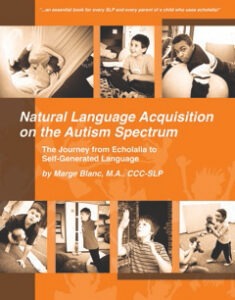Research
Research that validates the importance of gestalt language has been of three types, first the linguistic research of Ann Peters and colleagues which taught us that a child’s first ‘units of meaning’ are naturally-derived from the sound stream the infant hears. These units can be of any length, ranging from single words to long, multi-word chunks, or indistinct intonational contours. Regardless of length, each is processed as a single unit of meaning when the child is at the one-unit stage developmentally. The Units of Language Acquisition was published in 1983, republished as a .pdf in 2021, and included in the Library on this website.
The second avenue of research was accomplished by Barry Prizant and other SLPs who discovered communicative value in echolalia, both immediate and delayed. Neither is a pathology, and both serve normal communicative functions. Independent of Peters, Prizant et al discovered the language development value of ‘delayed echolalia,’ adopting the ‘gestalt’ terminology from Ann Peters. With their ground-breaking research, Prizant et al replaced ‘delayed echolalia’ in our minds with ‘gestalt language,’ and presented four stages of gestalt language development in the article, “Language Acquisition and Communicative Behavior in Autism: Toward an Understanding of the ‘Whole’ of It” (1983), included in the Library.
The third avenue of research combined the findings of Peters et al and Prizant et al, and detailed the gestalt language development process as described through longitudinal clinical research. Extending Prizant’s stages to six, and quantifying them for use in assessment, Blanc published Natural Language Acquisition on the Autism Spectrum: The Journey from Echolalia to Self-Generated Language in 2012. This book was endorsed by Barry Prizant as “the most comprehensive consideration of echolalia and language characteristics of persons with autism to date,” providing the link between the early research and Blanc’s continuing research.
If you haven’t looked at our Instagram posts yet, you will be presently surprised!
Even in that venue, we’ve been taking the ‘deep dive’ approach to NLA, and illustrating the topics we are learning more and more about! Join us there!
NLA Addendum #3
“Natural Language Acquisition on the Autism Spectrum: The Journey from Echolalia to Self-Generated Language is a wonderful resource that provides the most comprehensive consideration of echolalia and language characteristics of persons with autism to date.”
“In this seminal work, Marge Blanc, an experienced clinician and clinical researcher, brings us back to a crucial understanding of language characteristics and language acquisition in ASD based on her deep understanding of language development from a social-pragmatic, child-centered perspective. Unfortunately, too many educators and therapists hold on to outdated and disproven perceptions of echolalia and gestalt language and attempt to ‘treat’ echolalia with a lack of knowledge of the historical context and research basis of our understanding of language development in ASD.”
“By looking at echolalia only through a behavioral lens of pathology rather than through a developmental perspective based on research on autism and typical development, such practices may actually be hindering functional language development. It is hoped that this important work will help educators, therapists and parents move to more contemporary understandings and practices.”
“This book is a ‘must-read’ for all who care about supporting social communication for persons with ASD based on research and sound clinical practice.”
Barry M. Prizant, Ph.D., CCC-SLP
Adjunct Professor
Brown University
Director, Childhood Communication Services
Cranston, RI
Further research areas promise to shed light on several questions that are being discussed in various Study Groups on Facebook. These questions include how AAC can be successfully modified for GLPs, and how older students who begin the NLA process as teenagers or young adults can progress in language development. While prior research and continuing clinical practice is demonstrating that the process can continue well into the teen years and the early 20s, clinical data has not been fully collected or published.
If you have a teen or young adult or are one yourself, and want to contribute to new clinical research, please join the Facebook groups, and let us know!


